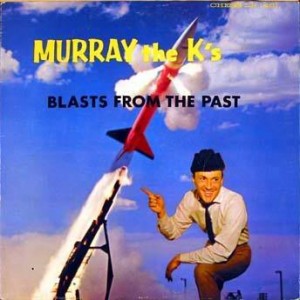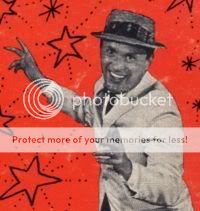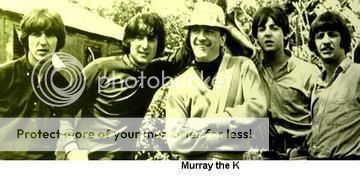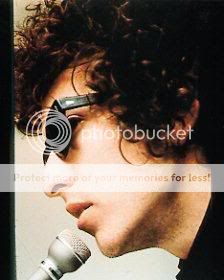Murray the K’s Blasts from the Past
|
 Murray Kaufman (February 14, 1922-February 21, 1982) professionally known as Murray the K, was a famous and influential rock and roll impresario and disc jockey of the 1950s, 60s, and 70s. During the early days of Beatlemania, he frequently referred to himself as “the Fifth Beatle”. Murray Kaufman (February 14, 1922-February 21, 1982) professionally known as Murray the K, was a famous and influential rock and roll impresario and disc jockey of the 1950s, 60s, and 70s. During the early days of Beatlemania, he frequently referred to himself as “the Fifth Beatle”.
Murray Kaufman came from a show business family: his mother, Jean, played piano in vaudeville and wrote music and his aunt was a character actress on the stage and in film. He was a child actor – an extra – in several Hollywood 1930s films. He attended a military boarding school, and later was inducted into the Army where he arranged entertainment for the troops. Following the war, he put together shows in the Catskills’ “Borscht Belt”, also doing warm-ups for the headline performers.
In the late ’40s and early ’50s, he worked in public relations and as a song plugger, helping to promote tunes like Bob Merrill’s “How Much Is That Doggie In The Window.” From there, he worked as a radio producer and co-host at WMCA (and briefly thereafter at WMGM), working with personalities such as Laraine Day on the late night interview program “Day At Night” and with Eva Gabor. At the same time, he was doing promotion for several baseball players, including Mickey Mantle and Wilie Mays, and his radio beginnings may be attributable to his connection with the New York Giants whose manager, Leo Durocher, was the husband of Laraine Day. His work on those shows earned him his own late-night show that often featured his wife as co-host, as was popular at the time. For a while in the 1950s he was president of the National Conference of Disk Jockeys.
 Kaufman’s big break came in 1958 after he moved to WINS-AMto do the all-night show, which he titled “The Swingin’ Soiree.” Shortly after his arrival, WINS’s high energy star disk jockey, Alan Freed, was indicted for tax evasion and forced off the air. Though Freed’s spot was briefly occupied by Bruce Morrow, who later became known as Cousin Brucie, Murray soon was moved into the 7-11PM time period and remained there for the next seven years, always opening his show with Sinatra and making radio history with his innovative segues, jingles, sound effects, antics, and frenetic, creative programming. Jeff Rice, writing in M/C Journal, says that Tom Wolfe calls Murray “the original hysterical disk jockey”.
 Murray the K reached his peak of popularity in the mid 1960s when, as the top-rated radio host in New York City, he became an early and ardent supporter and friend of The Beatles. When the Beatles came to New York in February, 1964, Murray was the first DJ they welcomed into their circle, having heard about him and his Brooklyn Fox shows from American acts who visited England. Murray did his radio show from their Plaza Hotel room their first night in New York and accompanied them to Washington, D.C. for their first U.S. concert, was backstage at their Ed Sullivan Show premiere, and roomed with Beatles guitarist George Harrison in Miami, broadcasting his shows from there. He came to be referred to as the”Fifth Beatle”, a nickname he says he was given either by Harrison during the train ride to the Beatles’ first concert in Washington D.C. or by Ringo Starr at a press conference before that concert. WINS (his radio station) picked up on the name and popularized it, billing him as the Fifth Beatle, a moniker he came to regret. He was invited to the set of A Hard Day’s Night in England and made several treks to England during 1964, giving WINS listeners more Beatle exclusives. Murray the K reached his peak of popularity in the mid 1960s when, as the top-rated radio host in New York City, he became an early and ardent supporter and friend of The Beatles. When the Beatles came to New York in February, 1964, Murray was the first DJ they welcomed into their circle, having heard about him and his Brooklyn Fox shows from American acts who visited England. Murray did his radio show from their Plaza Hotel room their first night in New York and accompanied them to Washington, D.C. for their first U.S. concert, was backstage at their Ed Sullivan Show premiere, and roomed with Beatles guitarist George Harrison in Miami, broadcasting his shows from there. He came to be referred to as the”Fifth Beatle”, a nickname he says he was given either by Harrison during the train ride to the Beatles’ first concert in Washington D.C. or by Ringo Starr at a press conference before that concert. WINS (his radio station) picked up on the name and popularized it, billing him as the Fifth Beatle, a moniker he came to regret. He was invited to the set of A Hard Day’s Night in England and made several treks to England during 1964, giving WINS listeners more Beatle exclusives. |

By the end of 1964, Murray found out that WINS was going to change to an all news format the following year. He resigned on the air in December ’64 (breaking news about the sale of the station and the change in format before the station and Group W released it) and did his last show on February 27 prior to the format change that occurred in April 1965. A year later, in 1966, the FCC ruled that AM and FM radio stations could no longer simply simultaneously broadcast the same content, opening the door for Murray to lead the FM rock radio revolution as program director and primetime dj on WOR-FM— the first FM rock station, soon airing such legendary djs as Rosko and Scott Muni in the new FM format. Murray played long cutting-edge album cuts rather than singles, often playing groups of songs by one artist, or thematically linked songs, uninterrupted by commercials. He created the ground-breaking FM radio format that would transform music radio, combining live in-studio interviews with folk-rock — he called it “attitude music” — and all forms of popular music in a free-form format. He played artists like Bob Dylan and Janis Ian, the long album versions of their songs that came to be known as the “FM cuts”. Al Aronowitz quotes Murray as saying, about his innovative FM formula, “You didn’t have to hype the record any more. The music was speaking for itself.”
 During that time Murray was often a champion of the much-maligned electric Bob Dylan. He introduced him to boos at a huge Forest Hills Tennis Stadium concert in August 1965, saying “It’s not rock, it’s not folk, it’s a new thing called Dylan.” He defended Dylan on a WABC-TV panel: “Even in his months of seclusion after the motorcycle accident, WABC-TV dedicated a television show to a discussion of what Bob Dylan was really like. When one member of the panel accused Dylan of all but inventing juvenile delinquency, there was only Murray the K to defend him. ‘Is Bob Dylan every kid’s father?’ Murray asked.” And he played his music, full length, on the radio.
During that time Murray was often a champion of the much-maligned electric Bob Dylan. He introduced him to boos at a huge Forest Hills Tennis Stadium concert in August 1965, saying “It’s not rock, it’s not folk, it’s a new thing called Dylan.” He defended Dylan on a WABC-TV panel: “Even in his months of seclusion after the motorcycle accident, WABC-TV dedicated a television show to a discussion of what Bob Dylan was really like. When one member of the panel accused Dylan of all but inventing juvenile delinquency, there was only Murray the K to defend him. ‘Is Bob Dylan every kid’s father?’ Murray asked.” And he played his music, full length, on the radio.
Throughout his New York radio career, Kaufman was renowned for the multi-racial rock ‘n’ roll shows he produced three or four times a year, usually during the Easter school recess, the week before Labor Day, and between Christmas and New Year at the Brooklyn Fox Theater. Those shows featured the top performers of the era and introduced new acts, such asDionne Warwick, Little Anthony & The Imperials, the Ronettes, the Shangri-Las, Gene Pitney, Ben E. King, the Four Tops, Wayne Newton, Bobby Vinton (who was the leader of the house band when he asked for a chance to perform as a singer), The Lovin’ Spoonful, Cream, and The Who among many others. He was known for promoting original black and latino artists.
|
|
I loved Murray, and I was going to use his voice on one of my recent nostalgia poems, where we all ahd our radios….Murrrrrrrrreeeeeeeee, Murrreeeee the Kaaaaaaay on the swinging soireeeee, with a blast! From the past! a goldie for youuuuuuuuuu!
|
 |
Yeah, he was great. I guess you think of him as I think of Alison Steele, the night bird.
|

 During that time Murray was often a champion of the much-maligned electric Bob Dylan. He introduced him to boos at a huge Forest Hills Tennis Stadium concert in August 1965, saying “It’s not rock, it’s not folk, it’s a new thing called Dylan.” He defended Dylan on a WABC-TV panel: “Even in his months of seclusion after the motorcycle accident, WABC-TV dedicated a television show to a discussion of what Bob Dylan was really like. When one member of the panel accused Dylan of all but inventing juvenile delinquency, there was only Murray the K to defend him. ‘Is Bob Dylan every kid’s father?’ Murray asked.” And he played his music, full length, on the radio.
During that time Murray was often a champion of the much-maligned electric Bob Dylan. He introduced him to boos at a huge Forest Hills Tennis Stadium concert in August 1965, saying “It’s not rock, it’s not folk, it’s a new thing called Dylan.” He defended Dylan on a WABC-TV panel: “Even in his months of seclusion after the motorcycle accident, WABC-TV dedicated a television show to a discussion of what Bob Dylan was really like. When one member of the panel accused Dylan of all but inventing juvenile delinquency, there was only Murray the K to defend him. ‘Is Bob Dylan every kid’s father?’ Murray asked.” And he played his music, full length, on the radio.


 Murray the K reached his peak of popularity in the mid 1960s when, as the top-rated radio host in New York City, he became an early and ardent supporter and friend of The Beatles. When the Beatles came to New York in February, 1964, Murray was the first DJ they welcomed into their circle, having heard about him and his Brooklyn Fox shows from American acts who visited England. Murray did his radio show from their Plaza Hotel room their first night in New York and accompanied them to Washington, D.C. for their first U.S. concert, was backstage at their Ed Sullivan Show premiere, and roomed with Beatles guitarist George Harrison in Miami, broadcasting his shows from there. He came to be referred to as the”Fifth Beatle”, a nickname he says he was given either by Harrison during the train ride to the Beatles’ first concert in Washington D.C. or by Ringo Starr at a press conference before that concert. WINS (his radio station) picked up on the name and popularized it, billing him as the Fifth Beatle, a moniker he came to regret. He was invited to the set of A Hard Day’s Night in England and made several treks to England during 1964, giving WINS listeners more Beatle exclusives.
Murray the K reached his peak of popularity in the mid 1960s when, as the top-rated radio host in New York City, he became an early and ardent supporter and friend of The Beatles. When the Beatles came to New York in February, 1964, Murray was the first DJ they welcomed into their circle, having heard about him and his Brooklyn Fox shows from American acts who visited England. Murray did his radio show from their Plaza Hotel room their first night in New York and accompanied them to Washington, D.C. for their first U.S. concert, was backstage at their Ed Sullivan Show premiere, and roomed with Beatles guitarist George Harrison in Miami, broadcasting his shows from there. He came to be referred to as the”Fifth Beatle”, a nickname he says he was given either by Harrison during the train ride to the Beatles’ first concert in Washington D.C. or by Ringo Starr at a press conference before that concert. WINS (his radio station) picked up on the name and popularized it, billing him as the Fifth Beatle, a moniker he came to regret. He was invited to the set of A Hard Day’s Night in England and made several treks to England during 1964, giving WINS listeners more Beatle exclusives.
Comments
Friday Fluff: Murray the K’s Blasts from the Past — No Comments
HTML tags allowed in your comment: <a href="" title=""> <abbr title=""> <acronym title=""> <b> <blockquote cite=""> <cite> <code> <del datetime=""> <em> <i> <q cite=""> <s> <strike> <strong>